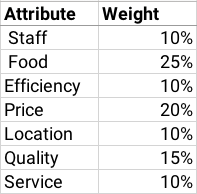A competitive analysis is the process of categorizing and evaluating your competitors to understand their strengths and weaknesses in comparison to your own. This analysis can cover a whole range of areas, metrics, and disciplines. Some of these will be more important dependent on who you are, but the more exhaustive you are the more effective your analysis will be. Competitive positioning articulates your posture in the ecosystem you operate in. [1].
Example
Say, you’re thinking of opening a local restaurant. You know that you will face a lot of competition from the incumbents and national chains. But, you have decided to compete with them by focussing on customer expectations. Correspondingly, you identify the main attributes as:
- Friendly, helpful and qualified staff
- High quality and assortment of locally produced food
- Efficiency service
- Affordable price
- Location easily accessible by public and private transport
You then create a matrix with the competitors on the left side and the quality attributes on the top. Then, you rank each competitor on each of the factors using a scale of 1-5. In this scale, 5 is the highest and 1 the lowers. The matrix might look something like this:

Competitive Score Matrix
This simple analysis tells you that Competitor 1 poses the greatest threat and should be the least worried about Competitor 3. However, what you failed to account for is the relative importance of each criterion.
Weighted Competitive Analysis
For a weighted competitive analysis matrix, you would follow these steps:
- Identify the most important dimensions that differentiate your product / service offerings
- Enumerate the attributes most important to your customers
- Identify your key competitors. Also, include any indirect competitors
- Assign a weight to each of the dimensions important to you and your customers. The total of all weights should equal 1.0
- Rate each competitor on each of these factors
- Multiply the rating of each competitor by the weighting of the success factor
The weights matrix might look as follows:

Attribute Weights
Additionally, the weighted analysis indicates how the overall score relates to the factors most important to your customers. For example, assortment and price are the most important factors. Although location is a factor, it is not significant enough to provide you an edge over others.
Competitive Positioning
Once you have analysed the competition, you should now articulate your posture to succeed in the marketplace. By creating a competitive positioning, you can identify areas of opportunity for your business. The available alternatives for strategic behaviour are:
- Aggressive position: If your company has a competitive advantage in an attractive and relatively stable industry, this should be your competitive positioning. In this case, you should protect your position and set up potential entry barriers for new competitors. Alternately, you may even consider new acquisitions, increasing market share, or launch competitive products
- Competitive position: If your company has a competitive advantage in an attractive, but relatively unstable industry, this should be your competitive positioning. In this case, your financial strength plays a significant role in establishing and maintaining your position. You should look for ways for horizontal and vertical integration, increasing production efficiency, and strengthening your cash position
- Conservative position: If your company has a competitive advantage in a stable industry with low growth rate, you should assume this competitive position. In this case, your product / service competitiveness are your critical success factors. You should protect your successful products / services and develop new ones. Develop strategies to penetrate the industry with attractive offerings and find ways to reduce costs
- Defensive position: If your company does not have a competitive advantage, you are in an unattractive industry, you lack competitive products, and financial resources, you should assume a defensive position. You should find ways to reduce costs and investments. If possible, consider leaving the industry
References
| ↑1 | How Competitive Forces Shape Strategy |
|---|




